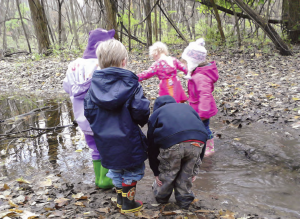Ten Steps to Starting a Nature Preschool

Originally appears in the Spring 2014 issue
SO, YOU’VE JUST RETURNED from an exciting conference and are anxious to start planning a nature preschool. Maybe it’s an idea you’ve had simmering for a while. Or, perhaps just the prospect of using environmental education with preschool age children is an intriguing idea. Whatever the case, as interest in environmental education programming for early childhood continues to swell, you might find yourself responsible for creating a formal nature-based preschool program one day.
Generally speaking, a nature preschool is a formalized environmental education opportunity for children ages three though six. There is no official definition of what constitutes a nature preschool. The structure can range from those that are mostly indoors and emphasize science instruction to European-style “forest schools” that take place completely outdoors. Academic content can also vary from kindergarten-readiness to simply focusing on building a life-long love and appreciation of nature. The day length and session length are also highly variable.
In recent years, nature preschools have experienced a surge in popularity. One major driving force has been popular literature aimed at raising public awareness of the need for spending time outdoors, such as Last Child in the Woods by Richard Louv. As our society continues to swap outdoor time for screen time, parents are becoming aware of the loss of the myriad physical, emotional, and social health benefits of outdoor time. Statistics from the US National Institute for Health reveal that youth ages 8-18 spend up to an average of 7.5 hours per day in front of a screen.
No matter the route you take, bringing such a dream to reality requires diligent planning and thoughtful analysis. Taking the time to lay a solid foundation can help you get your program off the ground more smoothly and will help you and/or your organization reach the public you serve more effectively.
The Countdown to Success
The enthusiasm you feel for environmental education and your conviction of its transformative power is, unfortunately, not enough to get a nature preschool off the ground. For “lift off” to take place, you will need a countdown, just like during a space launch. Here are the ten most important considerations and steps to take into account while planning your nature preschool.
10. Research the topic
Outline the purpose of the mission, what will be accomplished and how, the details of the ‘astrophysics’ involved, and look into the many other considerations you may have. The same holds true for your program planning efforts. Building up an understanding of the basics of nature preschools will make your launch smoother. You may want to investigate:
- The many different ways to carry out a nature preschool
- The various goals of nature preschools
- What funding support is available
- Best practices of other nature preschool programs
- Organizations, websites and training programs that support nature pre-schools
To view the photo-rich magazine version, click here.
if you are not already a subscriber, please subscribe to read the full article
Jessica Pierson is a Certified Interpretive Guide Trainer and a naturalist who lives in the suburbs of Chicago, Illinois. She is excited to begin her new career as a horticulture instructor this fall.
Leave a Reply
You must be logged in to post a comment.






Thanks for this informative post.
Pre schools in Vellore
Loving the information on this internet site, you have done great job on the articles.